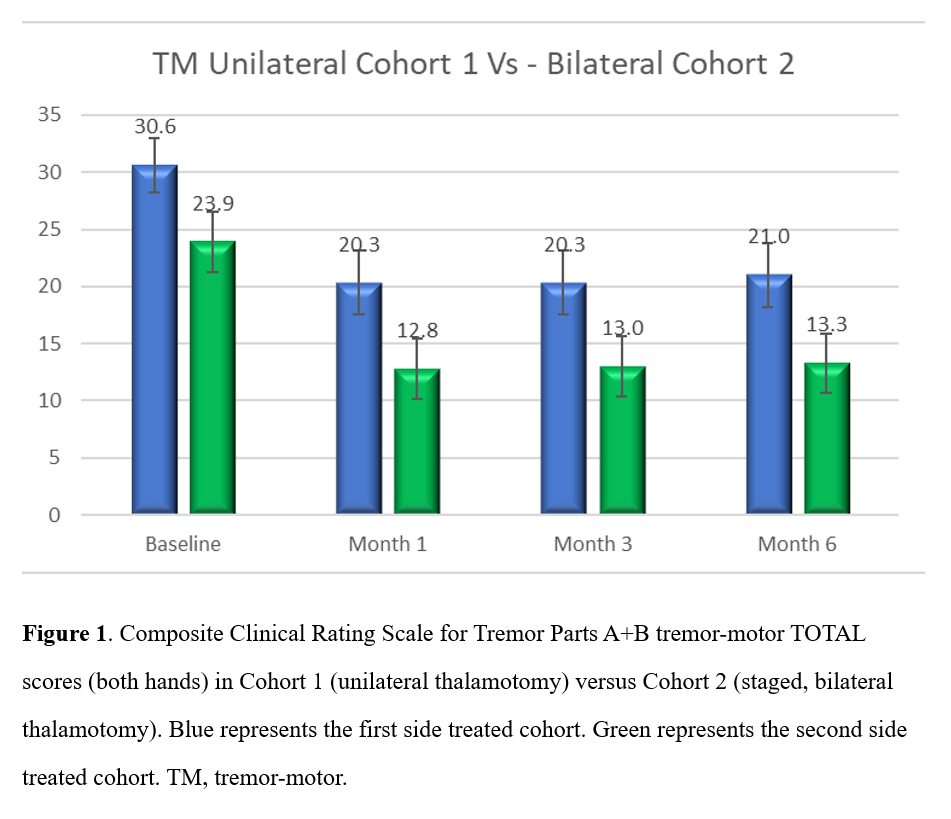Objective: This exploratory analysis investigated tremor-motor (TM) outcomes in patients receiving unilateral versus staged, bilateral magnetic resonance-guided focused ultrasound (MRgFUS) VIM thalamotomy for essential tremor (ET).
Background: Unilateral MRgFUS thalamotomy was approved for medication-refractory ET in 2016 based on a randomized controlled trial [1]; 5-year follow-up established its safety and durability [2]. Staged, bilateral MRgFUS thalamotomy was approved for ET in 2022 [3] based on an open-label study of a second, contralateral procedure at least 9 months after a unilateral procedure. The effect of unilateral and staged, bilateral treatment has not been compared previously.
Method: TM outcomes were compared between two separate, unmatched patient cohorts who underwent unilateral (Cohort 1, n = 49) [1] or staged, bilateral (Cohort 2, n = 51) thalamotomy, according to change from baseline in composite Clinical Rating Scale for Tremor Parts A and B TM TOTAL scores (sum of scores from treated and untreated side). Patients were followed at Months 1, 3 and 6. Whether treatment on one side affected the contralateral, untreated side was also examined.
Results: Unilateral treatment led to significant and sustained improvement. The TM TOTAL score improved 35%, from 31 points at baseline to 20 points during follow-up. TM scores on the untreated side were unchanged, suggesting no contralateral effect.
Staged, bilateral treatment led to significant and sustained improvement. The TM TOTAL score improved 46%, from 24 points at baseline to 13 points during follow-up. TM scores on the untreated (previously treated) side were unchanged, suggesting no contralateral effect.
A comparison of TM TOTAL scores indicated a 35% improvement from the endpoint of Cohort 1 (after first side treatment) to the endpoint of Cohort 2 (after second side treatment) [figure1].
Conclusion: Improvement in TM outcomes is similar between first and second side MRgFUS thalamotomy for ET. Second side treatment provides clinically meaningful improvement. All patients in Cohort 2 received second side treatment as part of a clinical trial. In practice, not all patients will choose to have staged, bilateral treatment as some achieve adequate control from unilateral treatment alone. The decision to receive staged, bilateral MRgFUS thalamotomy is between clinician and patient.
Figure 1
References: 1. Elias WJ et al. A randomized trial of focused ultrasound thalamotomy for essential tremor. N Engl J Med 2016;375(8):730-739.
2. Cosgrove GR et al. Magnetic resonance imaging-guided focused ultrasound thalamotomy for essential tremor: 5-year follow-up results. J Neurosurg 2022;138(4):1028-1033.
3. ExAblate® Model 4000 Type 1. Information for Prescribers. https://www.accessdata.fda.gov/cdrh_docs/pdf15/p150038c.pdf
To cite this abstract in AMA style:
HM. Eisenberg, P. Fishman, P. Ghanouni, M. Grassman, C. Ferrer, K. Gant, A. Grinspan. MR-guided focused ultrasound for essential tremor: exploratory analysis comparing unilateral and staged, bilateral thalamotomy [abstract]. Mov Disord. 2024; 39 (suppl 1). https://www.mdsabstracts.org/abstract/mr-guided-focused-ultrasound-for-essential-tremor-exploratory-analysis-comparing-unilateral-and-staged-bilateral-thalamotomy/. Accessed March 6, 2025.« Back to 2024 International Congress
MDS Abstracts - https://www.mdsabstracts.org/abstract/mr-guided-focused-ultrasound-for-essential-tremor-exploratory-analysis-comparing-unilateral-and-staged-bilateral-thalamotomy/

